|
|
|
Sort Order |
|
|
|
Items / Page
|
|
|
|
|
|
|
| Srl | Item |
| 1 |
ID:
136064
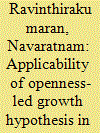

|
|
|
|
|
| Summary/Abstract |
An openness-led growth hypothesis investigates the causal relationship between trade openness1 and economic growth. Indeed, trade openness can stimulate economic growth by enhancing the international flow of knowledge and innovation and by allowing economies of specialization, not only in the production of goods, but also in the generation of new knowledge and new inputs into production. The purpose of this article is to empirically examine an openness-led growth hypothesis, using the case of Sri Lanka for the period from 1965 to 2012. The article uses the recently developed autoregressive distributed lag (ARDL) bounds test for cointegration developed by Pesaran et al. (2001). The empirical results confirm the validity of the openness-led growth hypothesis for Sri Lanka.
|
|
|
|
|
|
|
|
|
|
|
|
|
|
|
|
| 2 |
ID:
116736


|
|
|
|
|
| Publication |
2012.
|
| Summary/Abstract |
This contribution investigates causal interdependence between energy consumption and economic growth in Liberia and proposes application of a bootstrap methodology. To better reflect causality, employment is incorporated as additional variable. The study demonstrates evidence of distinct bidirectional Granger causality between energy consumption and economic growth. Additionally, the results show that employment in Liberia Granger causes economic growth and apply irrespective of the short-run or long-run. Evidence from a Monte Carlo experiment reveals that the asymptotic Granger causality test suffers size distortion problem for Liberian data, suggesting that the bootstrap technique employed in this study is more appropriate. Given the empirical results, implications are that energy expansion policies like energy subsidy or low energy tariff for instance, would be necessary to cope with demand exerted as a result of economic growth in Liberia. Furthermore, Liberia might have the performance of its employment generation on the economy partly determined by adequate energy. Therefore, it seems fully justified that a quick shift towards energy production based on clean energy sources may significantly slow down economic growth in Liberia. Hence, the government's target to implement a long-term strategy to make Liberia a carbon neutral country, and eventually less carbon dependent by 2050 is understandable.
|
|
|
|
|
|
|
|
|
|
|
|
|
|
|
|
| 3 |
ID:
116761
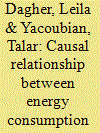

|
|
|
|
|
| Publication |
2012.
|
| Summary/Abstract |
This paper investigates the dynamic causal relationship between energy consumption and economic growth in Lebanon over the period 1980-2009. Within a bivariate framework, imposed on us due to data limitations, and in an effort to increase the robustness of our results, we employ a variety of causality tests, namely, Hsiao, Toda-Yamamoto, and vector error correction based Granger causality tests. We find strong evidence of a bidirectional relationship both in the short-run and in the long-run, indicating that energy is a limiting factor to economic growth in Lebanon. From a policy perspective, the confirmation of the feedback hypothesis warns against the use of policy instruments geared towards restricting energy consumption, as these may lead to adverse effects on economic growth. Consequently, there is a pressing need to revise the current national energy policy that calls for a 5% energy conservation target. Also, to shield the country from external supply shocks, given its substantial dependence on energy imports, policymakers should emphasize the development of domestic energy resources. Further, the most pertinent implication is that relaxing the present electric capacity shortages should be made a national priority, in view of its potential positive effect on the economy.
|
|
|
|
|
|
|
|
|
|
|
|
|
|
|
|
| 4 |
ID:
125580
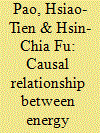

|
|
|
|
|
| Publication |
2013.
|
| Summary/Abstract |
This study investigates the causal relationship between clean and non-clean energy consumption and economic growth in Brazil over the period of 1980-2009. Clean energy consumption at aggregated level of total renewable energy consumption and disaggregated levels of hydroelectric, new renewables, and nuclear energy consumption are tested within a production function framework. A cointegration test reveals a long-term equilibrium relationship between real output, capital, labor, and renewable and non-renewable energy consumption at aggregated level, and a long-term equilibrium relationship between real output, capital, labor, and hydroelectric/new renewables/nuclear and fossil fuel energy consumption at disaggregated level. The capital, labor, and new renewables elasticities of real output are positive and statistically significant, other energy consumption item's elasticities are insignificant. The results from error correction model reveal the interdependencies between new renewables, nuclear, fossil fuel, and total non-renewable energy consumption and economic growth, the unidirectional causality from hydroelectric/total renewable consumption to economic growth, the substitutability between new renewables and fossil fuel consumption, and the substitutability between new renewables and nuclear energy consumption. Additionally, nuclear and new renewables energy consumption responds to bring the system back to equilibrium. Overall, aggregated analysis may obscure the relationship between different types of clean energy consumption and economic growth.
|
|
|
|
|
|
|
|
|
|
|
|
|
|
|
|
| 5 |
ID:
096643
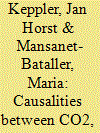

|
|
|
|
|
| Publication |
2010.
|
| Summary/Abstract |
The topic of this article is the analysis of the interplay between daily carbon, electricity and gas price data with the European Union Emission Trading System (EU ETS) for CO2 emissions. In a first step we have performed Granger causality tests for Phase I of the EU ETS (January 2005 until December 2007) and the first year of Phase II of the EU ETS (2008). The analysis includes both spot and forward markets-given the close interactions between the two sets of markets. The results show that during Phase I coal and gas prices, through the clean dark and spark spread, impacted CO2 futures prices, which in return Granger caused electricity prices. During the first year of the Phase II, the short-run rent capture theory (in which electricity prices Granger cause CO2 prices) prevailed. On the basis of the qualitative results of the Granger causality tests we obtained the formulation testable equations for quantitative analysis. Standard OLS regressions yielded statistically robust and theoretically coherent results.
|
|
|
|
|
|
|
|
|
|
|
|
|
|
|
|
| 6 |
ID:
097477
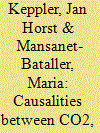

|
|
|
|
|
| Publication |
2010.
|
| Summary/Abstract |
The topic of this article is the analysis of the interplay between daily carbon, electricity and gas price data with the European Union Emission Trading System (EU ETS) for CO2 emissions. In a first step we have performed Granger causality tests for Phase I of the EU ETS (January 2005 until December 2007) and the first year of Phase II of the EU ETS (2008). The analysis includes both spot and forward markets-given the close interactions between the two sets of markets. The results show that during Phase I coal and gas prices, through the clean dark and spark spread, impacted CO2 futures prices, which in return Granger caused electricity prices. During the first year of the Phase II, the short-run rent capture theory (in which electricity prices Granger cause CO2 prices) prevailed. On the basis of the qualitative results of the Granger causality tests we obtained the formulation testable equations for quantitative analysis. Standard OLS regressions yielded statistically robust and theoretically coherent results.
|
|
|
|
|
|
|
|
|
|
|
|
|
|
|
|
| 7 |
ID:
132779


|
|
|
|
|
| Publication |
2014.
|
| Summary/Abstract |
Simultaneous rapid rise in both the world oil and agricultural commodity prices have increased interest in determining price transmission from oil prices to those of agricultural commodities. However, although a lot of the empirical research has studied the relation between oil price changes and economic activity, it is surprising that little research has been conducted on the relationship between oil price shocks and the large-size emerging industrial countries agricultural market. Therefore, the main goal of this study is that we are try to use the more detail and new China's weekly data which from 2004/9 to 2012/9 to fill this gap. This study examines the short and long-run interdependence between China fuel oil prices and the average of different kinds of key agricultural commodity prices in China. To this end, the Toda-Yamamoto causality approach and impulse response analysis method are applied to identification of the long and short-run interrelationships. In contrast to lots of the traditional causality analysis indicates that the oil prices and the agricultural commodity prices do not influence each other, our result is mix: we have inferred that the fluctuation of fuel oil price has a short-run effect on the dynamics of agricultural products in China; however, there are no significant in the long-run effects.
|
|
|
|
|
|
|
|
|
|
|
|
|
|
|
|
| 8 |
ID:
147497


|
|
|
|
|
| Summary/Abstract |
The rising trend in income inequality has recently attracted a renewed interest in the determinants of this growing trend across many countries. This article adds to the debate by investigating the impact of defence expenditure as a possible determinant of inequality in Taiwan, a country once was considered to be a poster child of an equitable growth, but now income inequality has become one of the Taiwan’s growing challenges. Applying the bounds test approach to cointegration and four long-run estimators for the period from 1976–2011, we found a long-run relationship between the various measures of inequality and defence expenditure where defence expenditure exerts a positive and a statistically significant impact on the worse income inequality in Taiwan. Further application of the lag-augmented causality test procedure also reveals a unidirectional causality running from defence expenditure to income inequality with defence expenditure causing income inequality to rise.
|
|
|
|
|
|
|
|
|
|
|
|
|
|
|
|
| 9 |
ID:
083234
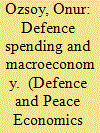

|
|
|
|
|
| Publication |
2008.
|
| Summary/Abstract |
This study uses a six-variable vector autoregressive (VAR) model and analyses the relationship between defence spending as a percentage of GNP, government budget as a percentage of GNP, total deficit as a percentage of GNP, the GNP growth rates, inflation rates, and government budget deficit as a percentage of GNP for the case of Turkey from 1933 to 2004. The impulse response functions (IRFs) are also derived and Granger causalities among the variables estimated. The results support the short-run causality between defence spending and economic growth.
|
|
|
|
|
|
|
|
|
|
|
|
|
|
|
|
| 10 |
ID:
091728
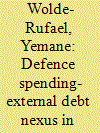

|
|
|
| 11 |
ID:
137933


|
|
|
|
|
| Summary/Abstract |
There are conflicting views as to the relationship between a nation’s defense expenditure (DE) and its population’s income inequality (INEQ). DE, always an important part of government budget, can easily crowd out transfer payments, necessary to improve INEQ; however, these payments may also create a demand that may raise the income levels of the lower income earners. Consequently, the relationship between DE and INEQ is an important question. This paper examines the relationship between DE and INEQ in China for the period of 1989–2012. Utilizing basic cointegration and causality tests, our objective is to add to the literature by providing evidence that China’s DE, in fact, do have an impact on INEQ.
|
|
|
|
|
|
|
|
|
|
|
|
|
|
|
|
| 12 |
ID:
182478
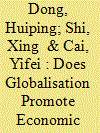

|
|
|
|
|
| Summary/Abstract |
This study aims to investigate whether globalisation promotes economic output in Sub-Saharan African countries in both the short run and the long run. Based on the latest version of the KOF globalisation index, we employ a newly developed bootstrap autoregressive distributed lag model to analyse this question. Compared to the traditional autoregressive distributed lag model, which ignores the degenerate cases, the new approach could avoid spurious cointegration. Results show that globalisation and economic output are positively correlated for most Sub-Saharan African countries, while the causal effect cannot be concluded except for a couple of exceptions. This finding implies that globalisation cannot guarantee an increase in economic output in the long run for most Sub-Saharan African countries. The Granger causality test shows that globalisation leads to economic output for Burundi, Gabon, Rwanda, Senegal and Zambia in the short run. Conversely, economic output leads to globalisation for Burkina Faso, Cameroon, Ghana, Kenya and Senegal. For Senegal, globalisation and economic output mutually determine each other and therefore form a positive spiral development path. Policymakers should be aware of the specific features of different economies in making sound globalisation policies to avoid the underlying adverse effects of global integration.
|
|
|
|
|
|
|
|
|
|
|
|
|
|
|
|
| 13 |
ID:
113474


|
|
|
|
|
| Publication |
2012.
|
| Summary/Abstract |
This paper examines cointegration relationships and Granger causality nexus in a trivariate framework among oil consumption, economic growth and international oil price in Portugal. For this purpose, we employ two Granger causality approaches: the Johansen cointegration test and vector error correction model (VECM) and the Toda-Yamamoto approaches. Cointegration test proves the existence of a long run equilibrium relationship among these variables and VECM and Toda-Yamamoto Granger causality tests indicate that there is bidirectional causality between crude oil consumption and economic growth (feed back hypothesis). Therefore, the Portuguese economy does not support crude oil conservation hypothesis. Consequently, policymakers should consider that implementing oil conservation and environmental policies may negatively impact on the Portuguese economic growth.
|
|
|
|
|
|
|
|
|
|
|
|
|
|
|
|
| 14 |
ID:
121350
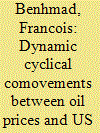

|
|
|
|
|
| Publication |
2013.
|
| Summary/Abstract |
In this paper, we use wavelet analysis to investigate the cyclical comovements between crude oil prices and US GDP, taking into account the decline in the volatility of US GDP growth that has occurred since the mid-1980s.
Our main findings suggest that before 1984:Q1, the crude oil prices were leading the US GDP cycle by 3 quarters and Granger cause US GDP. In contrast, after 1984:Q1, the crude oil prices were lagging the US business cycle, and a reverse causality is found to run from US GDP to oil prices. The multiscale Granger causality tests globally corroborate theses results.
|
|
|
|
|
|
|
|
|
|
|
|
|
|
|
|
| 15 |
ID:
122455


|
|
|
|
|
| Publication |
2013.
|
| Summary/Abstract |
Tourism is one of the largest and fastest growing industries in the world, which makes it a potential strategic factor for economic growth. This adds to the strong interest in the role of tourism in Malaysia's economic growth as it is the second-largest contributor to foreign exchange earnings after manufacturing. In addition, empirical results associated with Granger causality among economic growth, tourism and exports within the neoclassical framework are inconsistent. The objectives of this study, thus, are to determine: the long-run relationship; the long-run and short-run Granger causality; and the long-run triangular Granger causality between economic growth and tourism receipts corresponding to selected macroeconomic variables such as government tourism expenditure, physical capital, education, health and exports as control variables. The long-run Granger causality in vector error correction model (VECM) shows economic growth, tourism receipts and health complement each other (bidirectional causality), while unidirectional causalities are found between government tourism expenditure, physical capital, education and exports to economic growth. In addition, enhancing physical capital, education, health, exports and government tourism expenditure precede tourism receipts; all these in turn indirectly lead to economic growth, thus witnessing triangular relationships among them.
|
|
|
|
|
|
|
|
|
|
|
|
|
|
|
|
| 16 |
ID:
152760


|
|
|
|
|
| Summary/Abstract |
This article examines the effects of capital flows on economic growth in Senegal using autoregressive distributed lag (ARDL) over the period 1970–2014. Overall, our results show that remittances cause economic growth in Senegal in the long run. In contrast, external debt has a negative impact on economic growth. The ARDL results, however, show no cointegration between aid and growth or between foreign direct investment (FDI) and growth. The Quandt–Andrews breakpoint test selects year 1991 as the most likely breakpoint location for the remittances–growth equation. Finally, time-varying parameter analyses using the year 1991 as a slope dummy reveal that remittances have been growth-enhancing post-1991. Therefore, government and policy makers in Senegal must create a favourable atmosphere for attracting more remittances to promote economic development.
|
|
|
|
|
|
|
|
|
|
|
|
|
|
|
|
| 17 |
ID:
113432
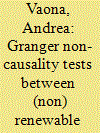

|
|
|
|
|
| Publication |
2012.
|
| Summary/Abstract |
The present paper considers an Italian dataset with an annual frequency from 1861 to 2000. It implements Granger non-causality tests between energy consumption and output contrasting methods allowing for structural change with those imposing parameter stability throughout the sample. Though some econometric details can differ, results have clear policy implications. Energy conservation policies hasten an underlying tendency of the economy towards a more efficient use of fossil fuels. The abandonment of traditional energy carriers was a positive change. The challenge for renewable energy is to diversify among different sources and to overcome possible social acceptance problems.
|
|
|
|
|
|
|
|
|
|
|
|
|
|
|
|
| 18 |
ID:
086215
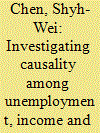

|
|
|
|
|
| Publication |
2009.
|
| Summary/Abstract |
This paper examines the long-run and causal relationships among unemployment, income and crime in Taiwan. The results clearly indicate that there is a long-run level equilibrium relationship among unemployment, income and total crime. There are also long-run relationships among unemployment, income and theft and among unemployment, income and economic fraud. The causality test results from the ECM-VAR and level VAR models indicate that there is a neutral relationship among unemployment, income and total crime, and a neutral relationship among unemployment, income and all three categories of crime. It is concluded that there is no strong evidence in favor of the unemployment-led crime (ULC) or the crime-led unemployment (CLU) hypotheses in Taiwan.
|
|
|
|
|
|
|
|
|
|
|
|
|
|
|
|
| 19 |
ID:
161490
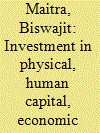

|
|
|
|
|
| Summary/Abstract |
This article studies the efficacy of the public investment in human capital and physical capital to raise income in Bangladesh over the period 1980–2016. This article also assesses whether the investment in human capital and income have raised life expectancy of the country. The Johansen cointegration test identifies a long-run relation of income with investment on education, health care and physical capital. The error correction mechanism (ECM) based on the cointegrating relation followed by the Wald test of Granger causality has found that these investments have caused income to rise with some lag periods. Robustness of these findings is confirmed by involving an autoregressive distributed lag (ARDL) model of cointegration followed by its ECM representation. On the other hand, the Johansen and ARDL methods of cointegration followed by their ECMs have also found a long-run relation of life expectancy with the investment in education, health care and income. A decisive role of the investment in health care and income on life expectancy is observed, while an unusual negative role of the investment in education is also found. However, positive value of the long-run coefficients of the education and health-care investments of the ECM-ARDL model indicate some long-run favourable impact of these investments on life expectancy in Bangladesh.
|
|
|
|
|
|
|
|
|
|
|
|
|
|
|
|
| 20 |
ID:
152763
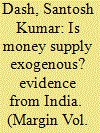

|
|
|
|
|
| Summary/Abstract |
Against the backdrop of the claim that the rising growth rate of money is one of the major factors behind India’s recent bout of elevated and sticky inflation, this article asks: Is money supply exogenous or endogenous, and can it predict future inflation. This question is investigated using the monetarist framework of inflation. In the empirical analysis of data spanning from 1970–71 to 2009–10, the results of both the monetarist and the error-correction models suggest that money supply accounts for inflation in India. There is also the presence of an error-correction mechanism among money, inflation and output. However, a monetarist equation does not tell anything about causality. Thus, the vector autoregression (VAR) method is used to detect the direction of causality between money supply and the inflation rate. Findings from Granger causality tests suggest weak evidence of inflation (Granger) causing money supply. As a robustness check, we estimate VAR models using quarterly data and, further, using core inflation. The results of the causality tests from the quarterly data, the impulse response function and forecast error variance decomposition suggest that money supply is weakly endogenous.
|
|
|
|
|
|
|
|
|
|
|
|
|
|
|
|
|
|
|
|
|